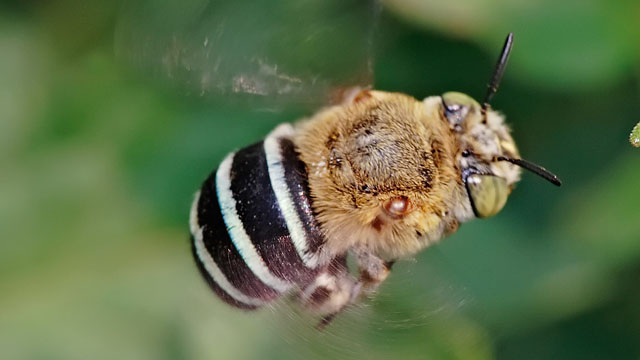Bees living near a mars chocolate bar factory in france started eating the sugary treats they began producing blue and green honey

Bees near a Mars Chocolate Bar Factory in France Produce Blue and Green Honey
 Image source: Heavy.com
Image source: Heavy.com
Bees are known for their incredible ability to produce honey, a delicious and nutritious treat for humans. However, in an extraordinary and unexpected turn of events, bees living near a Mars chocolate bar factory in France have not only been collecting nectar but also sampling sugary treats. As a result, these bees have started producing blue and green honey, leaving beekeepers both fascinated and concerned.
The unusual phenomenon of bees producing colored honey was first observed in the town of Ribeauville, located in northeastern France. Beekeepers, who typically enjoy golden honey from their hives, were baffled when they discovered their bees were bringing back a range of vibrant hues.
The bees’ newfound preference for Mars chocolate bars, resulting in blue and green honey, alarmed local beekeepers. They became concerned about the potential impact on the quality and marketability of their honey. Consequently, beekeepers began investigating the situation, determined to understand and rectify this peculiar scenario.
 Image source: Dreamstime
Image source: Dreamstime
It was discovered that bees living in proximity to the Mars chocolate bar factory had been attracted to the discarded remnants of the sugary confections. The bees had been feeding on a mixture of syrup and waste from the factory’s facilities, resulting in the unusual coloration of the honey.
The Mars factory, located in the Alsace region, produced a variety of chocolate bars, including the popular M&M’s, Milky Way, and Twix. The sweet residue emitted from the factory’s waste products was difficult for the bees to resist, leading them to collect the sugary substances and incorporate them into their honey production process.
While the blue and green honey captured the attention and curiosity of many, the beekeepers expressed deep concern. The unconventional honey posed potential risks, both for the bees themselves and the consumers of this colorful product. As a result, authorities conducted tests on the colored honey to visualize its impact on both the bees and human consumers.
The investigation revealed that although the blue and green honey may have appeared unusual, it did not pose any immediate health risks to humans. However, the long-term effects of bees consuming such quantities of processed sugar were yet to be fully understood.
Efforts were subsequently made to address the situation and prevent further contamination of honey reserves. The factory installed additional nets and barriers to prevent the bees’ access to the waste, helping to mitigate their attraction to the sugary treats.
The episode shed light on the potential consequences of industrial waste on natural ecosystems and the delicate balance of nature. It serves as a reminder that even seemingly harmless actions can reverberate throughout the environment.
As the investigation concluded, beekeepers near the Mars chocolate bar factory in France were relieved to discover that their bees gradually returned to producing honey of a more traditional hue. This incident, although captivating, prompted a reflective examination of our impact on the natural world and the importance of safeguarding the delicate relationship between human activities and wildlife.
Source: Reuters
Related Posts
Quick Links
Legal Stuff

